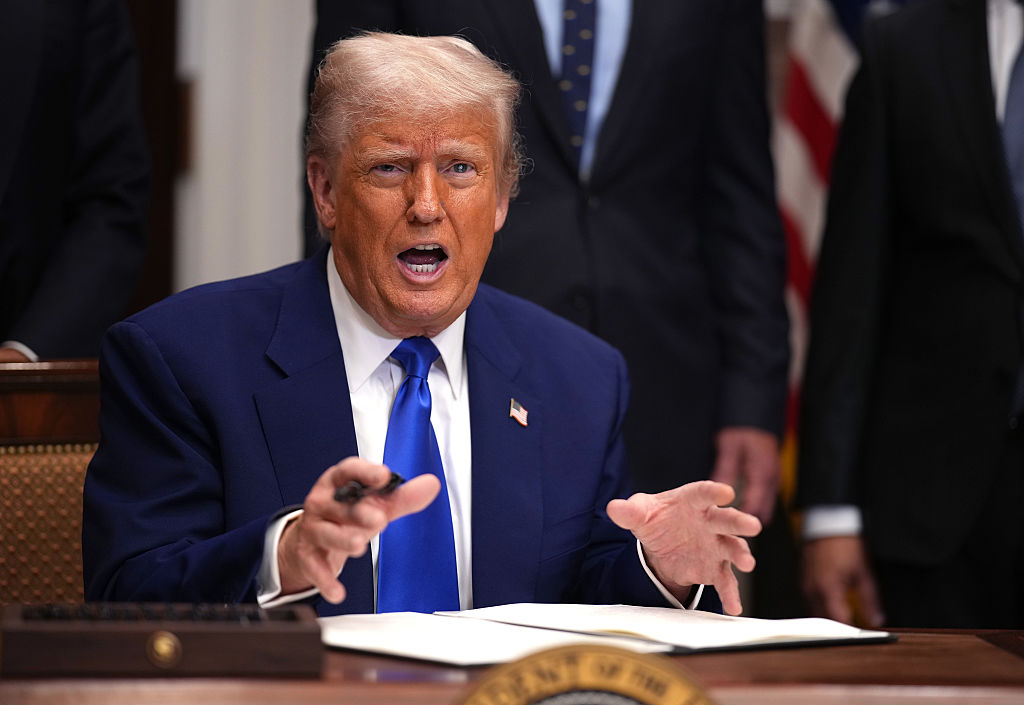Trump’s tariffs ravaged markets – but who were the winners and losers?
The US president’s ‘Liberation Day’ sent shockwaves through the market, with the S&P 500 falling by over 12% in one week. Some firms were better shielded than others.


When Donald Trump was elected for the second time as president of the United States, voters knew that they were in for some dramatic changes.
His new regime brought a drastic shift in the foreign policy ambitions of the US and a shake-up in virtually all arms of government.
Most significant for investors, though, was a new tariff regime, the impact of which has already changed the landscape of global trade.
MoneyWeek
Subscribe to MoneyWeek today and get your first six magazine issues absolutely FREE

Sign up to Money Morning
Don't miss the latest investment and personal finances news, market analysis, plus money-saving tips with our free twice-daily newsletter
Don't miss the latest investment and personal finances news, market analysis, plus money-saving tips with our free twice-daily newsletter
Trump announced his ‘Liberation Day’ tariffs on 2 April, implementing a blanket 10% tariff on all imported goods, as well as higher, so-called "reciprocal” tariffs on goods from countries that ran a trade deficit with the US.
As soon as trading began the following day, red was seen across virtually all constituents of the S&P 500.
As time marched on without the US president rowing back, the slump deepened with the S&P 500 falling by over 12% on its worst day on 8 April.
Thankfully for investors, Trump announced a 90-day pause of the so-called “reciprocal tariffs” on 9 April and markets rallied as a result.
The recovery then continued in the weeks following, perhaps most notably after China and the US agreed on a trade deal on 12 April that lowered tariffs on both countries for at least 90 days.
Chinese goods entering the US will now only be subject to additional tariffs of 30% (on top of the blanket 10% tariff on all goods), while US imports will face a 10% tariff in China.
The S&P 500 now sits around 3.8% higher than before ‘Liberation Day’ after a rally that saw an 18% rise between its low on 9 April and the end of trading on 13 May.
After a market whirlwind, there are naturally winners and losers. We look at which firms suffered the most in the immediate weeks after Trump’s tariffs, and which ones saw opportunity amid the chaos.
Who were the biggest winners from Trump’s tariffs?
Gold investors
Investors holding gold were already having a delightful time before Trump’s tariffs were announced, with gold prices having risen rapidly to around $3,500 in recent months.
When the new tariff regime was announced, gold rallied further.
The price of gold was around $3,126 per troy ounce on 2 April. This sharply fell to $2,967 on 7 April, but skyrocketed afterwards, briefly touching the $3,500 threshold on 22 April.
This rise was likely because gold is traditionally a safe-haven asset which tends to increase in price during downturns, according to Dan Coatsworth, investment analyst at AJ Bell.
“Investors have historically increased gold exposure during times of uncertainty and it’s fair to say that Liberation Day will go down in history as an event that turned the world upside down.
“Widespread uncertainties over the true economic impact of higher tariffs left investors shaken and many turned to so-called safe-haven investments,” he added.
Coatsworth notes that the higher gold prices will also provide a tailwind for gold-producing companies.
“While tariffs could eventually feed into higher costs of equipment and services to support gold extraction, investors will be banking on gold miners enjoying much greater cash flows and higher profit margins near-term thanks to the spike in the precious metal price,” he said.
Defence stocks
Many defence companies, already enjoying heightened stock prices following increased defence spending in Europe, also enjoyed a bump in the fortnight after ‘Liberation Day’.
US firms like Palantir Technologies saw their stock rise by around 6%, and defence giant Lockheed Martin also saw stock growth of 5.4% – the fourth and sixth largest rises in the S&P 500 during that period.
“Governments in many parts of the world have pledged to increase defence spending and that’s improved the earnings outlook for defence contractors,” says Coatsworth.
He further notes that, because defence spending is typically a percentage of GDP, “it would be wrong to assume that Trump’s tariffs would have zero impact on the sector because of how tariffs can lead to economic weakness.”
However, Coatsworth says that the impact of this could be overstated as “governments are unlikely to suddenly lower defence spending if they see a slowdown in GDP growth.”
The rise in defence stocks is not only a US trend, though. The UK’s own defence firms also enjoyed rising stock prices after the tariff announcement, with BAE Systems stock rising 10.9% between 2-10 April.
# | Name | Share price change |
|---|---|---|
1 | Newmont | 14.8% |
2 | UnitedHealth | 11.9% |
3 | Humana | 7.6% |
4 | Palantir Technologies | 6.0% |
5 | MarketAxess | 5.6% |
6 | Lockheed Martin | 5.4% |
7 | Huntington Ingalls | 5.2% |
8 | Northrop Grumman | 5.0% |
9 | Ross Stores | 4.8% |
10 | Copart | 3.4% |
Source: AJ Bell, ShareScope
# | Name | Share price change |
|---|---|---|
1 | Endeavour Mining | 19.6% |
2 | Fresnillo | 15.7% |
3 | 3i Group | 13.6% |
4 | Admiral | 11.3% |
5 | BAE Systems | 10.9% |
6 | Marks & Spencer | 10.4% |
7 | Associated British Foods | 10.2% |
8 | Berkeley | 9.7% |
9 | United Utilities | 8.2% |
10 | Severn Trent | 7.7% |
Source: AJ Bell, ShareScope
Who were the biggest losers from Trump’s tariffs?
Between the start of trading on 3 April and the end of 4 April, the S&P 500 fell by over 10%, making it the fourth-worst two day change since 1950.
This fall was only eclipsed by some of the market panic that occurred during the Covid-19 pandemic, Black Monday, and the 2008 Financial Crisis.
Unsurprisingly, there were a lot of losers in the fortnight after ‘Liberation Day’.
Tech stocks
Tech stocks are some of the most popular equities to hold for investors thanks to their historically high growth.
However, following the tariff chaos, the Magnificent Seven did not look so magnificent.
A significant fall among this group came from Apple, whose stock price slumped by almost 25% on 8 April amid the tariff chaos.
Apple may be more exposed to complications in global trade than other firms as the vast majority of iPhones are manufactured in China.
As US tariffs on Chinese goods climbed to an eye-watering 145% before the trade deal was announced on 12 April, it is no wonder that shareholders were worried about the prospects of the company.
Thankfully for investors, the dramatic 25% slump was temporary and stocks finished the fortnight around 13% down – not great by any means, but much better than what could have been.
Another Magnificent Seven firm that saw its stock price tank in the aftermath of Trump’s tariffs was Tesla.
The electric car maker has seen its share price suffer a prolonged fall since December amid disappointing sales figures and earnings with Tesla shares going down by around 53% from 17 December to 8 April.
What’s more, the political entanglement of its billionaire CEO Elon Musk helped drive the decline as investors worried that he was spending too much time in his role at Trump’s Department of Government Efficiency (DOGE).
Read our piece on whether you should invest in Tesla for more detail.
A table showing how the stock price of the Magnificent Seven fared in the two weeks after tariff day can be found below:
Name | Percentage change 2 April to 16 April |
|---|---|
Nvidia | -5.37 |
Alphabet | -2.11 |
Amazon | -11.06 |
Apple | -13.22 |
Meta | -13.97 |
Microsoft | -2.75 |
Tesla | -14.57 |
Firms exposed to trade flows
As Trump’s tariffs impact any company that imports products from outside the US into it, many firms whose business model relies on free trade saw their stock prices dip.
On the FTSE 100, distribution and outsourcing firm Bunzl saw its stock fall by 24.5% as its business model is severely exposed to the threat of tariffs.
“Bunzl provides essential products for companies to do business – but not products that are sold to the end customer. On 16 April, it flagged weaker trading in North America and the shares were knocked for six,” says Coatsworth.
This was also the case in the US. Coatsworth notes the example of Intertek whose shares are “likely to have fallen as investors worry about a slowdown in products moving to and from the US because of tariffs”.
He added: “Intertek is a testing specialist and its services include checking if cargos contain exactly what they say they do. Therefore, it is heavily exposed to trade flows.”
The biggest loser: the American economy?
Perhaps the biggest loser, however, could be the US – the country’s economy was the envy of the world before ‘Liberation Day’. Now, many analysts are expecting a downturn.
On 11 April, Blackrock CEO Larry Fink said in an interview with CNBC: ““I think we’re very close, if not in, a recession now.”
He added that this was due to the uncertainty and slowdown in global trade that such a dramatic tariff policy would create.
Fink is not the only one who now thinks that the American economy could enter into a recession.
On April 15, J.P. Morgan said that the probability of the US entering into a recession before the end of 2025 was 60%.
Bruce Kasman, chief global economist at J.P. Morgan, said: “Even with the latest step-back from the draconian Liberation Day measures, what remains is still enough to push the U.S. and China — and thus likely the global economy — into a recession this year.”
The biggest fallers
APA, the parent company of oil and gas exploration firm Apache, saw its stock price drop by 27.6%, thanks to the disruption to global trade that was expected on the horizon, according to data gathered by AJ Bell.
Albemarle, a chemicals manufacturing company with plants in China, India, Japan, and other locations outside the US, also saw its share price drop dramatically by 27.2%.
Meanwhile, Warner Bros Discovery also had a poor fortnight. The media giant lost 25% in stock price in just two weeks after disappointing earnings
The largest fall in the S&P 500 was Charles River Laboratories which lost 30% in share price.
However, it is worth noting that, while the bearish state of the market during the tariff tumult may have played some part in this drop, the biomedical firm’s stock price was moved more by a change-up in regulation.
A table showing the percentage change in stock price in the fortnight after tariff day can be found below:
# | Name | Share price change |
|---|---|---|
1 | Charles River Laboratories | -30.0% |
2 | APA | -27.6% |
3 | Albemarle | -27.2% |
4 | Stanley Black & Decker | -26.2% |
5 | Warner Bros Discovery | -25.0% |
6 | Estee Lauder | -23.4% |
7 | Devon Energy | -22.7% |
8 | GE Healthcare Technologies | -22.5% |
9 | Carmax | -22.5% |
10 | Microchip Technology | -22.4% |
Source: AJ Bell, ShareScope
# | Name | Share price change |
|---|---|---|
1 | Bunzl | -24.5% |
2 | BP | -18.2% |
3 | Pershing Square Holdings | -13.5% |
4 | Shell | -12.4% |
5 | Standard Chartered | -11.6% |
6 | Intermediate Capital | -11.5% |
7 | Melrose Industries | -11.5% |
8 | HSBC | -10.8% |
9 | IMI | -9.8% |
10 | Intertek | -9.4% |
Source: AJ Bell, ShareScope
Which sectors have been left behind in the month after Liberation Day?
Despite the higher “reciprocal” tariffs for most countries being paused for 90 days, significant damage has been done to certain sectors in the UK stock market with many firms yet to recover.
In particular, the oil and pharmaceutical sectors were hit hardest by news of tariffs and share prices in the sectors are yet to rebound, according to data from AJ Bell.
The UK and US announced a trade deal recently, on 8 May, which mostly targeted the steel, aluminium, and automobile sectors. UK pharmaceuticals will also get “preferential treatment” as a part of the deal, but it is unclear what exactly this will mean.
Oil companies
As oil companies are hugely exposed to changes in export and import regulations, the prospect of paying higher tariffs to enter the world’s largest economy was not welcome news for investors.
What’s more, fears of a global trade war also shook investors as they anticipated it would hurt the global economy and reduce overall demand for energy, says Coatsworth at AJ Bell.
As a result of this the share prices of oil producers listed on the FTSE were significantly down from 2 April to 12 May, with BP’s share price tanking by 10%, and Shell’s down further by 12%.
In the time since Trump’s tariff pause and 12 May, some more promising developments have emerged. One notable point was that the perceived likelihood of a US recession fell with the tariff rowback, helping push oil prices up.
The most significant development came when China and the US announced a trade agreement on 12 May, prompting the Brent Crude oil price to move up by 2.5% to $65.79 a barrel. Reacting to this news, BP and Shell’s share price moved up by a similar amount.
Though the outlook does seem more promising for the FTSE’s oil firms as the worst of the tariff chaos seems to be over, Coatsworth says “there are other dynamics at play which means there is still a long way to go for BP and Shell’s shares to get back to pre-Liberation Day levels.”
He points towards supply and demand dynamics in the oil market, noting that the OPEC+ cartel of oil producers is pumping more supply into an already-supplied market, pushing the price of oil down.
Though falling oil prices are unlikely to do BR and Shell’s earnings any favours, Coatsworth does say, “the flipside is that this could help to offset some of the inflationary pressures caused by tariffs”.
Pharmaceutical companies
Another sector that has been slow to get back on its feet after ‘Liberation Day’ is the UK pharmaceutical sector.
Firms like AstraZeneca and GSK have been consistently falling since 2 April as investors worry about whether they will be able to push through trade barriers and ship their goods into the US.
Though Trump initially excluded pharmaceutical companies from the excessive tariffs he announced, the famously mercurial president indicated that it was just a temporary solution and that tariffs would be imposed in the future.
This uncertainty has naturally worried investors in the UK, prompting the share prices of AstraZeneca and GSK to fall by 12% and 6% respectively from 2 April to 12 May.
But investors’ worries for UK pharma don’t just stop at trade uncertainty. Coatsworth notes that US demand for UK pharmaceuticals could fall “if US customers find cheaper alternatives to AstraZeneca or GSK products”.
“Reduced sales could have a negative knock-on effect and hurt spending on research and development down the line,” he added.
Which UK shares have performed worst since Liberation Day?
Since ‘Liberation Day’ the FTSE 100 has been slow to grow again. From 2 April to 12 May, the value of the index was almost flat, only falling by 0.04%.
It is a similar story for the FTSE 350, which has grown by just over 0.5% in the same time period.
Though sub-1% growth is nothing to brag about, many firms in the FTSE should be happy that they avoided the worst of the tariff crash.
A list of the ten worst-performing firms in the FTSE 350 from 2 April to 12 May can be found below:
Company | Share price loss since 2 April 2025 | Reason |
|---|---|---|
Playtech | -50% | Trading without rights to special dividend |
Mobico | -49% | Asset sale price disappointment and warning |
Bunzl | -17% | Profit warning |
THG | -17% | Weak trading update |
Harbour Energy | -15% | Shares down on weaker oil price |
WAG Payment Solutions | -13% | Fears it could be hit by economic slowdown |
AstraZeneca | -12% | Worries over tariffs and drug pricing |
BP | -12% | Shares down on weaker oil price |
Bridgepoint | -11% | Fears of slowdown in private equity sector |
Hunting | -11% | Shares down on weaker oil price |
Source: AJ Bell, ShareScope. Data as of 12 May 2025.
Get the latest financial news, insights and expert analysis from our award-winning MoneyWeek team, to help you understand what really matters when it comes to your finances.
Daniel is a financial journalist at MoneyWeek, writing about personal finance, economics, property, politics, and investing.
He is passionate about translating political news and economic data into simple English, and explaining what it means for your wallet.
Daniel joined MoneyWeek in January 2025. He previously worked at The Economist in their Audience team and read history at Emmanuel College, Cambridge, specialising in the history of political thought.
In his free time, he likes reading, walking around Hampstead Heath, and cooking overambitious meals.
-
 Boost for over 100,000 families on Child Benefit as new HMRC payment system rolled out
Boost for over 100,000 families on Child Benefit as new HMRC payment system rolled outThousands of households will no longer have to pay the dreaded High Income Child Benefit Charge through self-assessment
-
 Are you being haunted by the ghost of Christmas past? How festive cutbacks could boost your long-term wealth
Are you being haunted by the ghost of Christmas past? How festive cutbacks could boost your long-term wealthThe average family spends around £1,000 over the Christmas season. Here’s how much you could have gained if you had invested some of the money instead.
